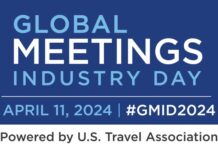
While some progress has been made in some countries, wait times to get a U.S. visa remain an insurmountable roadblock for some international travelers to U.S. events.
It’s no secret that long visa wait times are a problem for U.S. meetings and events looking to draw an international audience. In fact, first-time visitors to the U.S. from some of the top inbound markets can expect to face more than 400 days of waiting, according to usvisadelays.com, part of the U.S. Travel Association (USTA) “They Wait, We Lose” campaign. Some countries are still experiencing 800-plus-day wait times.
“I can’t get colleagues and clients to U.S.-based exhibitions that we either attend or produce,” says one event organizer on the usvisadelays site. “Have written numerous times to local congresswoman who refers petition to State department. Nothing gets solved; business is lost.” Another relates to a Columbia-based employee of a Miami-based trade show organizer who faced an 18-month waiting time to apply for a B1/B2 visa. “I tried many, many times to reschedule to an earlier date through the US Embassy in Colombia website, I applied for an emergency appointment, and even our CEO wrote to the Florida state representative asking for assistance in expediting the interview date, to no avail,” that person wrote.
All this frustration costs more than just peace of mind, of course. USTA estimates the U.S. will lose 2.6 million visitors and $7 billion in spending this year due to international travelers’ inability to secure a visitor visa. These losses make it more difficult to achieve the Biden administration’s goal of attracting 90 million international visitors and $279 billion in spending annually by 2027, according to the association.
But Wait, There Is Some Progress
Progress is being made, however. Wait times for U.S. visitor visas for applicants in India began dropping earlier this spring, falling from 669 days in mid-March to 337 days in early April. While that’s still not exactly speedy, that 50% drop is an indication that the steps taken by the U.S. Department of State to reduce extreme visitor visa delays are starting to have an effect. One of these strategies, as tweeted by the U.S. Embassy in India, was “Travelers with ‘clearance received’ or ‘department authorization’ on their previous visas can now use the interview waiver process to apply for a new visa.” Also helping are surging consulate staffing and expanding operating hours to Saturdays.
“The results we’re seeing in India are proof that—with the right tools—State can make significant progress on this issue,” said U.S. Travel Association (USTA) President and CEO Geoff Freeman. “However, there is clearly more work ahead to lower wait times worldwide.”
India is one of the top source markets for inbound U.S. travelers, according to USTA. USTA also is urging the State Department to put in place similar strategies to those that are working in India for visa applicants from other top countries. As of May 24, visa applicants in Brazil still face wait times of 527 days. Would-be U.S. travelers from another top market, Mexico, also still face a daunting wait time of 647 days.
Stay Informed on Visa Wait Times
Meeting and event organizers can keep up to date on the potential visa wait times at travel.state.gov, which provides the current wait times for an interview at a U.S. embassy or consulate. However, while there are some circumstances under which a visa application can be expedited — generally unforeseeable situations such as funerals and medical emergencies — “participating in an annual business/academic/professional conference” is not one of them, according to the State Department.
While it’s unclear how many of these frustrated would-be visitors are potential attendees, sponsors and exhibitors at U.S. shows, the overall problem is clear. Where inbound travel used to generate a potential trade surplus of $86 billion in 2015 — making inbound travel the U.S. top services export — that number dropped to just $3 billion last year.
Competitive Disadvantage
USTA points out that, among the top 10 inbound markets whose citizens require tourist visas to visit the U.S., six — Mexico, Brazil, Colombia, Argentina, Israel and Venezuela — can travel visa-free to the European Union, five can travel without visas to the United Kingdom, and two can travel without visas to Canada.
“No one will wait years for a visa to visit the U.S. when so many other countries welcome global travelers with open arms,” said Freeman. “The State Department must continue to make international visitors an economic priority before we lose them to other destinations.”
USTA is not the only organization voicing concerns over the competitive disadvantage these long visa wait times have on inbound U.S. travel and their businesses. Earlier this year, hotel executives such as Marriott CEO Anthony Capuano publicly pleaded for the Biden Administration to do something to reduce that average 400-day wait time. Hilton CEO Chris Nasetta also has pointed to the visa wait time issue as a key one for the industry. More than 40 mayors and city officials from Arizona to Washington also sent a letter to Department of State Secretary Anthony Blinken in February to apply some of the tactics that have worked to speed up visa wait times for students, seasonal workers and crew members to first-time visitor visa applicants.
“From the progress that your agency has achieved in other visa classifications, it’s clear that the State Department is capable of taking positive steps on visa issuance when it devotes adequate resources to swift and focused processing,” the city officials said in their letter. “We ask that you make international visitor visa processing a top priority and eliminate what is currently a major deterrent to tourism in the United States.”
You May Also Be Interested In…
Did You Know These Countries Have U.S. Travel Advisories?
World’s Busiest Airports Near Pre-Pandemic Passenger Levels










